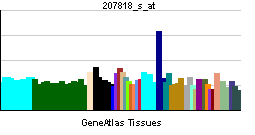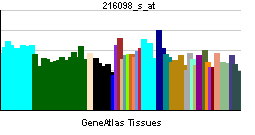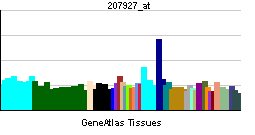5-HT7 receptor
| 5-hydroxytryptamine (serotonin) receptor 7 (adenylate cyclase-coupled) | |||||||||||
|---|---|---|---|---|---|---|---|---|---|---|---|
| Identifiers | |||||||||||
| Symbols | HTR7 ; 5-HT7 | ||||||||||
| External IDs | Template:OMIM5 Template:MGI HomoloGene: 20244 | ||||||||||
| |||||||||||
| RNA expression pattern | |||||||||||
 | |||||||||||
 | |||||||||||
 | |||||||||||
| More reference expression data | |||||||||||
| Orthologs | |||||||||||
| Template:GNF Ortholog box | |||||||||||
| Species | Human | Mouse | |||||||||
| Entrez | n/a | n/a | |||||||||
| Ensembl | n/a | n/a | |||||||||
| UniProt | n/a | n/a | |||||||||
| RefSeq (mRNA) | n/a | n/a | |||||||||
| RefSeq (protein) | n/a | n/a | |||||||||
| Location (UCSC) | n/a | n/a | |||||||||
| PubMed search | n/a | n/a | |||||||||
5-hydroxytryptamine (serotonin) receptor 7 (adenylate cyclase-coupled), also known as HTR7, is a human gene.[1]
The neurotransmitter, serotonin, is thought to play a role in various cognitive and behavioral functions. The serotonin receptor encoded by this gene belongs to the superfamily of G protein-coupled receptors and the gene is a candidate locus for involvement in autistic disorder and other neuropsychiatric disorders. Three splice variants have been identified which encode proteins that differ in the length of their carboxy terminal ends.[1]
Ligands
There are several ligands that binds to the 5-HT7 receptor
- N-(1,2,3,4-Tetrahydronaphthalen-1-yl)-4-aryl-1-piperazinehexanamides[2]
- 8-OH-DPAT (5-HT1A/7 agonist)[3]
- SB-269970 (antagonist)[4]
See also
References
- ↑ 1.0 1.1 "Entrez Gene: HTR7 5-hydroxytryptamine (serotonin) receptor 7 (adenylate cyclase-coupled)".
- ↑ Leopoldo M, Lacivita E, Contino M, Colabufo NA, Berardi F, Perrone R (2007). "Structure-activity relationship study on N-(1,2,3,4-tetrahydronaphthalen-1-yl)-4-aryl-1-piperazinehexanamides, a class of 5-HT7 receptor agents. 2". J. Med. Chem. 50 (17): 4214–21. doi:10.1021/jm070487n. PMID 17649988.
- ↑ Sprouse J, Reynolds L, Li X, Braselton J, Schmidt A (2004). "8-OH-DPAT as a 5-HT7 agonist: phase shifts of the circadian biological clock through increases in cAMP production". Neuropharmacology. 46 (1): 52–62. doi:10.1016/j.neuropharm.2003.08.007. PMID 14654097.
- ↑ P. J. Lovell; et al. (2000). "A novel, potent, and selective 5-HT7 antagonist : (R)-3-(2-(2-(4-methylpiperidin-1-yl)-ethyl)pyrrolidine-1-sulfonyl)phenol (SB-269970)". Journal of Medicinal Chemistry. 43 (3): 342&ndash, 345. PMID 10669560.
Further reading
- Hoyer D, Hannon JP, Martin GR (2002). "Molecular, pharmacological and functional diversity of 5-HT receptors". Pharmacol. Biochem. Behav. 71 (4): 533–54. PMID 11888546.
- Raymond JR, Mukhin YV, Gelasco A; et al. (2002). "Multiplicity of mechanisms of serotonin receptor signal transduction". Pharmacol. Ther. 92 (2–3): 179–212. PMID 11916537.
- Gelernter J, Rao PA, Pauls DL; et al. (1995). "Assignment of the 5HT7 receptor gene (HTR7) to chromosome 10q and exclusion of genetic linkage with Tourette syndrome". Genomics. 26 (2): 207–9. PMID 7601444.
- Ullmer C, Schmuck K, Kalkman HO, Lübbert H (1995). "Expression of serotonin receptor mRNAs in blood vessels". FEBS Lett. 370 (3): 215–21. PMID 7656980.
- Bard JA, Zgombick J, Adham N; et al. (1993). "Cloning of a novel human serotonin receptor (5-HT7) positively linked to adenylate cyclase". J. Biol. Chem. 268 (31): 23422–6. PMID 8226867.
- Lovenberg TW, Baron BM, de Lecea L; et al. (1993). "A novel adenylyl cyclase-activating serotonin receptor (5-HT7) implicated in the regulation of mammalian circadian rhythms". Neuron. 11 (3): 449–58. PMID 8398139.
- Heidmann DE, Metcalf MA, Kohen R, Hamblin MW (1997). "Four 5-hydroxytryptamine7 (5-HT7) receptor isoforms in human and rat produced by alternative splicing: species differences due to altered intron-exon organization". J. Neurochem. 68 (4): 1372–81. PMID 9084407.
- Erdmann J, Nöthen MM, Shimron-Abarbanell D; et al. (1997). "The human serotonin 7 (5-HT7) receptor gene: genomic organization and systematic mutation screening in schizophrenia and bipolar affective disorder". Mol. Psychiatry. 1 (5): 392–7. PMID 9154233.
- Jasper JR, Kosaka A, To ZP; et al. (1997). "Cloning, expression and pharmacology of a truncated splice variant of the human 5-HT7 receptor (h5-HT7b)". Br. J. Pharmacol. 122 (1): 126–32. doi:10.1038/sj.bjp.0701336. PMID 9298538.
- Lassig JP, Vachirasomtoon K, Hartzell K; et al. (1999). "Physical mapping of the serotonin 5-HT(7) receptor gene (HTR7) to chromosome 10 and pseudogene (HTR7P) to chromosome 12, and testing of linkage disequilibrium between HTR7 and autistic disorder". Am. J. Med. Genet. 88 (5): 472–5. PMID 10490701.
- Krobert KA, Levy FO (2002). "The human 5-HT7 serotonin receptor splice variants: constitutive activity and inverse agonist effects". Br. J. Pharmacol. 135 (6): 1563–71. doi:10.1038/sj.bjp.0704588. PMID 11906971.
- Norum JH, Hart K, Levy FO (2003). "Ras-dependent ERK activation by the human G(s)-coupled serotonin receptors 5-HT4(b) and 5-HT7(a)". J. Biol. Chem. 278 (5): 3098–104. doi:10.1074/jbc.M206237200. PMID 12446729.
- Strausberg RL, Feingold EA, Grouse LH; et al. (2003). "Generation and initial analysis of more than 15,000 full-length human and mouse cDNA sequences". Proc. Natl. Acad. Sci. U.S.A. 99 (26): 16899–903. doi:10.1073/pnas.242603899. PMID 12477932.
- Slominski A, Pisarchik A, Zbytek B; et al. (2003). "Functional activity of serotoninergic and melatoninergic systems expressed in the skin". J. Cell. Physiol. 196 (1): 144–53. doi:10.1002/jcp.10287. PMID 12767050.
- Simonin F, Karcher P, Boeuf JJ; et al. (2004). "Identification of a novel family of G protein-coupled receptor associated sorting proteins". J. Neurochem. 89 (3): 766–75. doi:10.1111/j.1471-4159.2004.02411.x. PMID 15086532.
- Gerhard DS, Wagner L, Feingold EA; et al. (2004). "The status, quality, and expansion of the NIH full-length cDNA project: the Mammalian Gene Collection (MGC)". Genome Res. 14 (10B): 2121–7. doi:10.1101/gr.2596504. PMID 15489334.
- Brüss M, Kiel S, Bönisch H; et al. (2005). "Decreased agonist, but not antagonist, binding to the naturally occurring Thr92Lys variant of the h5-HT7(a) receptor". Neurochem. Int. 47 (3): 196–203. doi:10.1016/j.neuint.2005.03.003. PMID 15896881.
- Ikeda M, Iwata N, Kitajima T; et al. (2006). "Positive association of the serotonin 5-HT7 receptor gene with schizophrenia in a Japanese population". Neuropsychopharmacology. 31 (4): 866–71. doi:10.1038/sj.npp.1300901. PMID 16192982.
This article incorporates text from the United States National Library of Medicine, which is in the public domain.
| Stub icon | This membrane protein–related article is a stub. You can help Wikipedia by expanding it. |